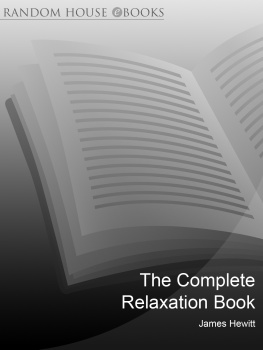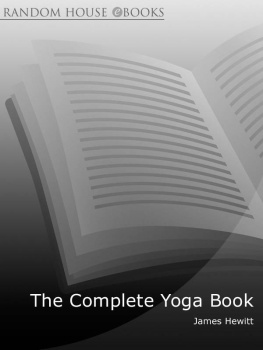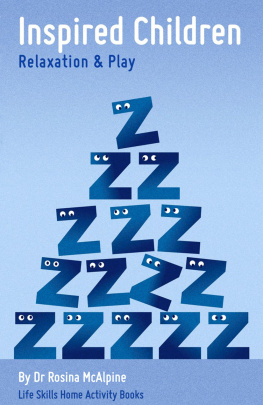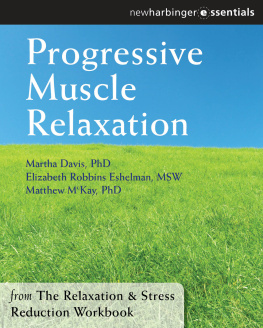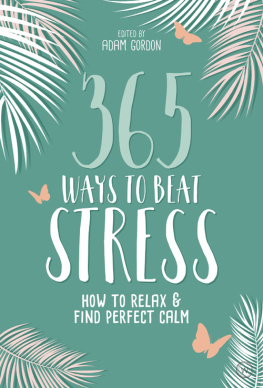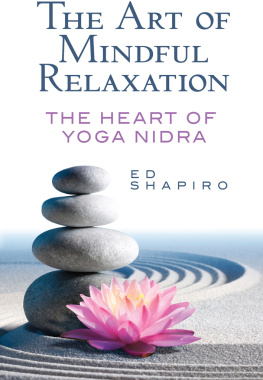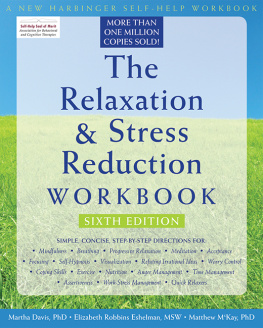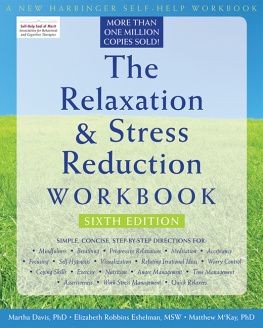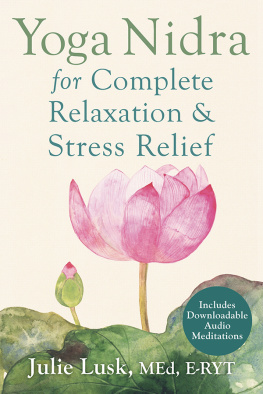Contents
The Complete Relaxation Book
James Hewitt

About the Book
Stress is a major cause of disease today. This book is a manual of instruction in the art of relaxation. Based on thirty years of study and experience, it is a unique synthesis of the techniques of Western therapies and Eastern mysticism.
James Hewitt starts with a survey of those empirical, Western relaxation techniques which yield physical and emotional benefits: progressive relaxation, self-hypnosis, autogenic training, biofeedback, and posture and breathing exercises. These exercises relax tense minds as well as tense muscles, and open up the possibility of peak experiences. Carried over into everyday life, the deep psycho-physical relaxation they induce leads to enhanced, poised living and integrated well-being.
He then turns to an examination of Oriental techniques such as Yoga, Zen and other Buddhist methods. The reader can then find the technique most suited to his temperament and situation.
(Previously published as Relaxation East and West)
Also by James Hewitt
The Complete Yoga Book
Preface
Looking now at the contents of my youthful works on relaxation and at the plan of the present volume, I discern two main differences. Missing in the earlier works were the presentation of meditation as a method of deep relaxation, and, apart from tentative pointers, discussion of what might be called relaxations wider dimensions. These were discoveries I made later, through study and practice.
The relaxation that is the subject of this book is not relaxation in the popular usage of the word, as a transient respite from work and from the cares and responsibilities of living. This book is about deep psychophysical relaxation which scientific investigation shows to be deeper in several ways than deep sleep and about carrying relaxation into everyday thought, feeling and activity, manifested as poised living.
It is connected, too, with the profoundest experiences known to human consciousness, however you choose to interpret them. Relaxation followed right through offers a way even a Way in the Eastern sense of a mystical path to expansion of consciousness, to greater freedom from conditioning, to spiritual unfoldment and experiential wisdom.
THE BOOK IN OUTLINE
relaxation and to show how relaxation can be the basis for an art of poised living, which can be achieved despite the stressful nature of modern life. Poised living is not just a health-protection method or a therapy. It is a lifestyle for the development of full humanness (self-actualization) and for letting go and opening up to mindfulness of being.
describes progressive relaxation, the primary Western therapeutic method of deep muscular relaxation. Relaxation is taught here as a neuromuscular skill, which can be learned like any other, such as buttoning a coat or driving a car. By developing your kinaesthetic sense, or muscle awareness, you can learn to recognize tension in the skeletal muscles and to let go from it that is, relax the muscles. This is done progressively from toes to scalp; the muscles controlling speech and imagery, associated with thinking, may also be relaxed.
is concerned with the application of muscular relaxation skill in everyday activities, using minimum effort for maximum effect. Muscles not essential for any action should be relaxed (differential relaxation). Energy is saved, efficiency increased.
gives instruction in self-hypnosis, with suggestions for deep relaxation. It should be noted that all hypnosis is in a sense auto-hypnosis, as the cooperation of the subject is essential. Self-hypnosis can be learned by most people and the minds remarkable capacity to respond to implanted suggestions harnessed for dissolving tensions, changing habits, treating illnesses, inducing confidence, self-improvement and for personal growth.
discusses autogenic training which has attracted much interest in Europe, although therapists in Britain and the USA have been slower to use it. It resembles both progressive relaxation and self-hypnosis and uses auto-suggestion to induce feelings of muscle heaviness, warmth and so on.
beyond voluntary control. Although the subject is not sure how he or she is doing it, brainwave rhythms can be altered, blood pressure lowered, and deep relaxation induced all in response to monitored signals on electrical instruments. A principle of let it happen is the key to success, just as it is in all relaxation methods and in Eastern tranquillity practices.
describes the important techniques of poised posture and poised breathing. If the body is carried well and harmoniously balanced, actions are performed with the minimum of fatigue, and the lungs and other internal organs have room to function well. Body posture also influences inner posture. In this chapter we see how Zen posture and the Alexander method may be combined.
describes methods of meditation that are acceptable to everyone: simple techniques that calm body and mind. The physiology of meditation has been studied by Western scientists who have found it to be one of the simplest ways of eliciting the relaxation response. Some people see meditation as a way to higher consciousness or to enlightenment.
deals with the continuing benefits of meditation in day-to-day living. Any activity in daily life can become a medium for meditation awareness. Mindfulness or bare attention is a mental hygiene, defeating stress, heightening perception and triggering peak experiences, which develops detachment and self-knowledge.
opens with an account of how auto-suggestion may be used in states of deep relaxation which give contact with the unconscious mind. Relaxation is an essential preliminary to the manifestation of most so-called paranormal powers. When the conscious mind and will are pacified, the deep-seated true will may emerge. Relaxation is also the essence of the peak experience moments of delight, meaning, and ego-transcendence. Mystical experience may be viewed as the ultimate relaxation experience. The chapter concludes with a discussion of altered consciousness and the possibility of higher states of consciousness.
practices and gives a picture of the likely attitudes, psychology, philosophy and world view of the man or woman realizing a poised life. The characteristics of poised living are largely those described by Abraham H. Maslow for self-actualizing people. Peace of mind can be sustained in plateau living. Poised living finds inspiration in philosophical Taoism, which teaches a special feeling for Nature and letting go to lifes flow. The spirit of philosophical Taoism continues to animate Zen. Ordinary living is effortless flow and constant celebration.
1 Letting Go for Life
THIS BOOK IS a manual of instruction in the art of relaxation, or letting go, at various levels, employing techniques from both Western therapies and Eastern mystical traditions in a fruitful synthesis.
The practice of letting go releases tension from body and mind and opens up awareness thereby improving health and protecting against disease, conserving and integrating energy, enhancing psychophysical skills, and promoting psychophysical poise. Letting go is essential to tapping the deep-rooted powers of the unconscious mind and to expansion of the minds reaches. At its highest cultivation, letting go from the tension-knot that is the ego or I-process triggers the freedom, spontaneity and enlightenment that is the ultimate goal of the mystical traditional systems.
THE ESOTERIC PSYCHOLOGIES
It should be noted that the mystical religions of the East are primarily esoteric psychologies, using meditation supported by postural training and the cultivation of certain ego-dropping attitudes, to attain enlightenment and a transformation of the quality of consciousness. The paths they describe are open to all, and in the last twenty years or so Western interest in them has grown considerably.
Next page
